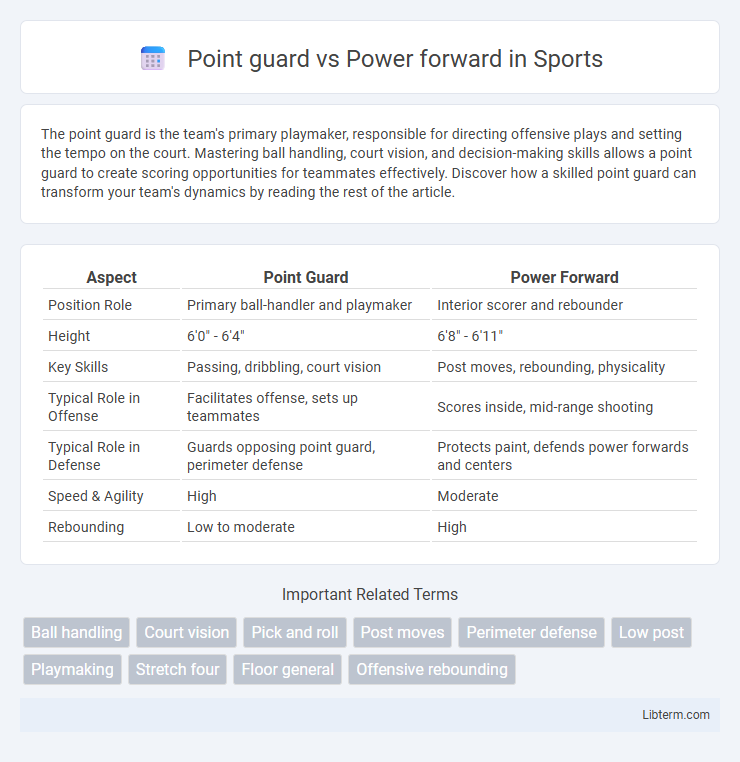The point guard is the team's primary playmaker, responsible for directing offensive plays and setting the tempo on the court. Mastering ball handling, court vision, and decision-making skills allows a point guard to create scoring opportunities for teammates effectively. Discover how a skilled point guard can transform your team's dynamics by reading the rest of the article.
Table of Comparison
| Aspect | Point Guard | Power Forward |
|---|---|---|
| Position Role | Primary ball-handler and playmaker | Interior scorer and rebounder |
| Height | 6'0" - 6'4" | 6'8" - 6'11" |
| Key Skills | Passing, dribbling, court vision | Post moves, rebounding, physicality |
| Typical Role in Offense | Facilitates offense, sets up teammates | Scores inside, mid-range shooting |
| Typical Role in Defense | Guards opposing point guard, perimeter defense | Protects paint, defends power forwards and centers |
| Speed & Agility | High | Moderate |
| Rebounding | Low to moderate | High |
Introduction to Point Guard and Power Forward Roles
Point guards serve as the primary ball handlers and playmakers, orchestrating the offense by distributing passes and setting up scoring opportunities. Power forwards typically operate near the basket, focusing on rebounding, interior defense, and scoring through post moves or mid-range jump shots. Their contrasting roles highlight the point guard's emphasis on agility and court vision versus the power forward's strength and physical presence.
Key Responsibilities on the Court
Point guards orchestrate offensive plays, control ball distribution, and facilitate scoring opportunities through precise passing and strategic decision-making. Power forwards focus on rebounding, interior defense, and scoring in the paint with post moves and mid-range shooting. Both positions require strong court awareness but serve distinct roles in team dynamics and play execution.
Physical Attributes and Skill Sets
Point guards typically possess exceptional agility, speed, and ball-handling skills, enabling precise playmaking and court vision essential for directing the offense. Power forwards exhibit greater physical strength, size, and rebounding ability, specializing in post plays, interior defense, and mid-range shooting. While point guards emphasize quick decision-making and perimeter skills, power forwards focus on physical dominance and versatility in both scoring and defending near the basket.
Offensive Contributions Compared
Point guards excel in ball handling and playmaking, orchestrating the offense with precise assists and perimeter shooting, often driving the tempo of the game. Power forwards contribute through strong post moves, mid-range shooting, and offensive rebounds, creating second-chance scoring opportunities. While point guards primarily create offense through distribution and agility, power forwards impact scoring via physical presence and versatility in the paint.
Defensive Impact: Point Guard vs Power Forward
Point guards excel in perimeter defense, using quickness and agility to disrupt opposing ball handlers and initiate fast breaks, while power forwards dominate interior defense with strength and rebounding ability to protect the paint. The defensive impact of a point guard lies in their ability to pressure the ball and create turnovers, whereas power forwards contribute by contesting shots and securing defensive rebounds. Effective team defense often relies on the complementary defensive roles of both positions to guard multiple areas on the court.
Leadership and Playmaking Differences
Point guards excel in leadership through orchestrating offensive plays, utilizing exceptional court vision and decision-making to distribute the ball effectively. Power forwards lead by setting physical screens, controlling rebounds, and providing inside scoring, often influencing the game's pace with their presence in the paint. While point guards direct team dynamics and facilitate scoring opportunities, power forwards assert leadership via physicality and versatility in both offense and defense.
Rebounding and Scoring Roles
Point guards typically prioritize playmaking and perimeter scoring, averaging around 5 to 7 points per game with a focus on assists rather than rebounding. Power forwards contribute significantly to rebounding, often securing 7 to 12 rebounds per game, and provide scoring mainly in the post with averages of 12 to 18 points. The distinct roles emphasize ball distribution and outside shooting for point guards, while power forwards excel in inside scoring and controlling the boards.
Versatility and Adaptability on the Team
Point guards typically showcase exceptional court vision and playmaking skills, enabling them to adapt quickly to various offensive schemes and facilitate team coordination. Power forwards contribute versatility through their ability to score inside, rebound, and defend multiple positions, often switching between perimeter and post play. Their combined adaptability enhances overall team dynamics, with point guards orchestrating plays and power forwards executing versatile roles in both offense and defense.
Famous Point Guards and Power Forwards in History
Famous point guards like Magic Johnson and Stephen Curry revolutionized basketball with their exceptional ball-handling, court vision, and playmaking abilities, setting new standards for leadership on the floor. Power forwards such as Tim Duncan and Karl Malone dominated through physicality, rebounding, and scoring versatility, anchoring their teams' defenses and offenses alike. The contrast between the agility and strategic mindset of point guards and the strength and inside presence of power forwards defines key roles that have evolved with legends shaping basketball's history.
Choosing the Right Position for Your Play Style
Point guards excel in ball handling, court vision, and playmaking, ideal for players who prioritize speed, passing, and orchestrating offense. Power forwards thrive in physicality, rebounding, and inside scoring, suiting athletes emphasizing strength, post moves, and defense. Selecting the right position depends on your core skills, physical attributes, and preferred role in team dynamics.
Point guard Infographic

 libterm.com
libterm.com